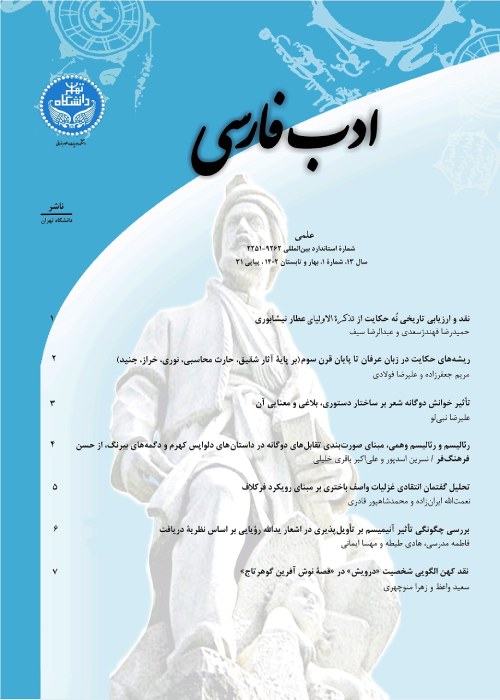A Comparative Study of Narrative Structure in The Book of Job from The Old Testament and “The Tale of Job’s Misery” from Stories of the Quran by Atiq Nishaburi (Surabadi) Using Algirdas Greimas’s Model
Author(s):
Article Type:
Research/Original Article (دارای رتبه معتبر)
Abstract:
The story of Job the prophet is one of the narratives included in both The Quran and The Old Testament but narrated differently in each of them. Despite similarities in form and content, the narrative in The Old Testament and the narratives by interpreters of The Quran differ in terms of plot structure. Adopting Algirdas Greimas’s narratological model as well as his semiotics of discourse and using descriptive-analytical method, the present study conducts a comparative analysis of narrative structure in The Book of Job from The Old Testament and one of the Islamic narratives of the same story, namely “The Tale of Job’s Misery” from the ancient Persian text Stories of the Quran by Aboubakr Atiq Nishaburi (Surabadi). To this aim, first, the actantial model, narrative chains, and plot structure are concisely explained according to Greimas’s theory; then, the events, characters, and narrative structure are analyzed and compared in the two selected narratives of Job’s story. Finally, this study concludes that the plot of The Book of Job is contractual, whereas that of “The Tale of Job’s Misery” is performative. Moreover, in both texts, Yahweh/God is the sender, but the most striking difference is the devil/Satan, who is not an actant in The Book of Job, while he is the opponent and the performing subject in the Islamic narrative. Besides, in these two narratives, the function of the disrupter of the pattern is attributed to different characters. The analysis of the process of semiosis, the evolution of narrative structure, and the role of modal verbs shows that in the Islamic narrative the active-tensive system and in The Book of Job the existential-tensive system form the dominant discourse in the creation of meaning.
Keywords:
Language:
Persian
Published:
Persian Literature, Volume:11 Issue: 2, 2022
Pages:
93 to 114
magiran.com/p2427465
دانلود و مطالعه متن این مقاله با یکی از روشهای زیر امکان پذیر است:
اشتراک شخصی
با عضویت و پرداخت آنلاین حق اشتراک یکساله به مبلغ 1,390,000ريال میتوانید 70 عنوان مطلب دانلود کنید!
اشتراک سازمانی
به کتابخانه دانشگاه یا محل کار خود پیشنهاد کنید تا اشتراک سازمانی این پایگاه را برای دسترسی نامحدود همه کاربران به متن مطالب تهیه نمایند!
توجه!
- حق عضویت دریافتی صرف حمایت از نشریات عضو و نگهداری، تکمیل و توسعه مگیران میشود.
- پرداخت حق اشتراک و دانلود مقالات اجازه بازنشر آن در سایر رسانههای چاپی و دیجیتال را به کاربر نمیدهد.
دسترسی سراسری کاربران دانشگاه پیام نور!
اعضای هیئت علمی و دانشجویان دانشگاه پیام نور در سراسر کشور، در صورت ثبت نام با ایمیل دانشگاهی، تا پایان فروردین ماه 1403 به مقالات سایت دسترسی خواهند داشت!
In order to view content subscription is required
Personal subscription
Subscribe magiran.com for 70 € euros via PayPal and download 70 articles during a year.
Organization subscription
Please contact us to subscribe your university or library for unlimited access!



